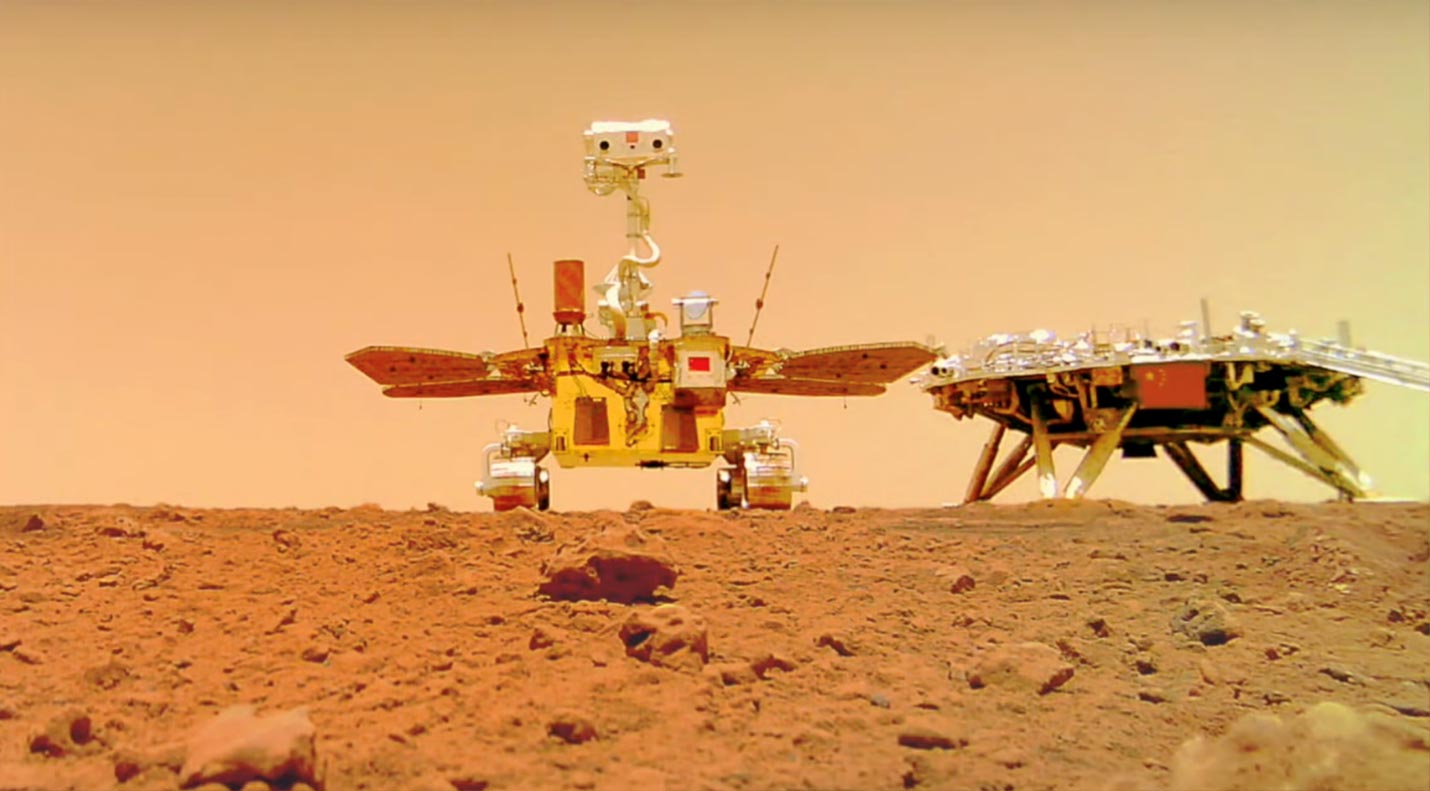
A selfie taken by the Jurong rover on its landing stage, captured by a wireless camera. Credit: China National Space Administration
Zhurong rover, part of China’s Tianwen-1[{” attribute=””>Mars mission, has found evidence of liquid water at low Martian latitudes, indicating potentially habitable environments. This discovery, contradicting previous beliefs that water could only exist in solid or gaseous states on Mars, was made by analyzing morphological features and mineral compositions of dunes in the landing area.
The Zhurong rover has found evidence of water on dune surfaces on modern Mars by providing key observational proof of liquid water at low Martian latitudes, according to a study led by Prof. Xiaoguang Qin from the Institute of Geology and Geophysics (IGG) of the Chinese Academy of Sciences (CAS).
The study was published on April 28 in the journal Science Advances.
Researchers from the National Astronomical Observatories of CAS and the Institute of Atmospheric Physics of CAS were also involved in the study.

Water traces on bright sand dunes. (a) Topographic contour map of the environs where the trace is located. The coordinate system is east-north-up (ENU) local Cartesian coordinate and the origin is that of the rover coordinate system. The background Digital Orthophoto Map (DOM) photo was taken by NaTeCam. (b) MSCam bird’s-eye-view photo showing a strip-like trace and a likely water-soaked fragmented soil block. (c) Enlarged photo showing polygonal cracks and bright polygonal ridges. (d) Enlarged photo showing circular region with the strip-like trace as a part. (e) NaTeCam 3D image of an interdune depression between two dark longitudinal dunes. (f) A cross-section of the dune along the profile of the white dash line in (e). Credit: IGGCAS
Previous studies have provided proof of a large amount of liquid water on early Mars, but with the escape of the early Martian atmosphere during the later period, the climate changed dramatically. Very low pressure and water vapor content make it difficult for liquid water to sustainably exist on Mars today. Thus, it has been widely believed that water can only exist there in solid or gaseous forms.
Nonetheless, droplets observed on the Phoenix’s robotic arm prove that salty liquid water can appear in the summer at current high latitudes on Mars. Numerical simulations have also shown that climatic conditions suitable for liquid water can briefly occur in certain areas of Mars today. Until now, though, no evidence has shown the presence of liquid water at low latitudes on Mars.
Now, however, findings from the Zhurong rover fill the gap. The Zhurong rover, which is part of China’s Tianwen-1 Mars exploration mission, successfully landed on Mars on May 15, 2021. The landing site is located at the southern edge of the Utopia Planitia (UP) Plain (109.925 E, 25.066 N), where the northern lowlands unit is located.
The researchers used data obtained by the Navigation and Terrain Camera (NaTeCam), the Multispectral Camera (MSCam) and the Mars Surface Composition Detector (MarSoDe) on board the Jurong rover. landing area.
They found some important morphological features in dune surfaces like ridges, cracks, granulation, polygonal ridges and a strip-like trace. Analysis of spectral data shows that the dune superficial layer is rich in hydrated sulfates, hydrated silica (especially opal-Cd), trivalent iron oxide minerals (especially ferrihydrite), and chlorides.
“Based on meteorological data measured by Jurong and other Mars rovers, we hypothesized that these dune surface features are related to the involvement of liquid salt water formed by melting snow/ice that falls on the surface of the salt dunes during cooling,” said Professor Qin.
Specifically, the salts in the dunes cause the frost/snow to melt at low temperatures to form saline liquid water. As the brine dries, precipitated hydrated sulfate, opal, iron oxide, and other hydrated minerals cement sand particles into sand aggregates and crusts. The crust then cracks further due to shrinkage. A later freeze/thaw process also creates polygonal ridges and strip-like traces on the crustal surface.
The estimated age of the dunes (ca. 0.4–1.4 million years) and the relationship between the three phases of water suggests that water vapor shifted from the polar ice towards the equator during the great gradients of the late Amazonian period on Mars. Repeated humid environments at low latitudes. Therefore, a scenario of water activity is proposed, namely, that cooling at low latitudes during Martian great gradients induces frost/snow to fall, resulting in crusts and aggregates forming on the surface of salt dunes, thus solidifying the dunes and leaving traces. Liquid salt water activity.
The discovery provides key observational evidence of liquid water in Mars’ low latitudes, where surface temperatures are relatively warmer and more suitable for life than at high latitudes.
“This is important for understanding the evolutionary history of the Martian climate, the search for a habitable environment, and providing important clues for the future search for life,” Professor Qin said.
Reference: “Modern Water in Low Latitudes on Mars: Possible Evidence from Dune Surfaces” Xiaoguang Qin, Xin Ren, Xu Wang, Jianjun Liu, Haibin Wu, Xingguo Zeng, Yong Sun, Zhaoopeng Chen, Shihao Zhang, Yizhong Zhang, Wangli Chen, Bin Liu, Dawei Liu, Lin Guo, Konggang Li, Xiangzhao Zheng, Hai Huang, Qing Zhang, Changsheng Yu, Chunlai Li, and Zhengdong Guo, 28 April 2023, Scientific advances.
DOI: 10.1126/sciadv.add8868